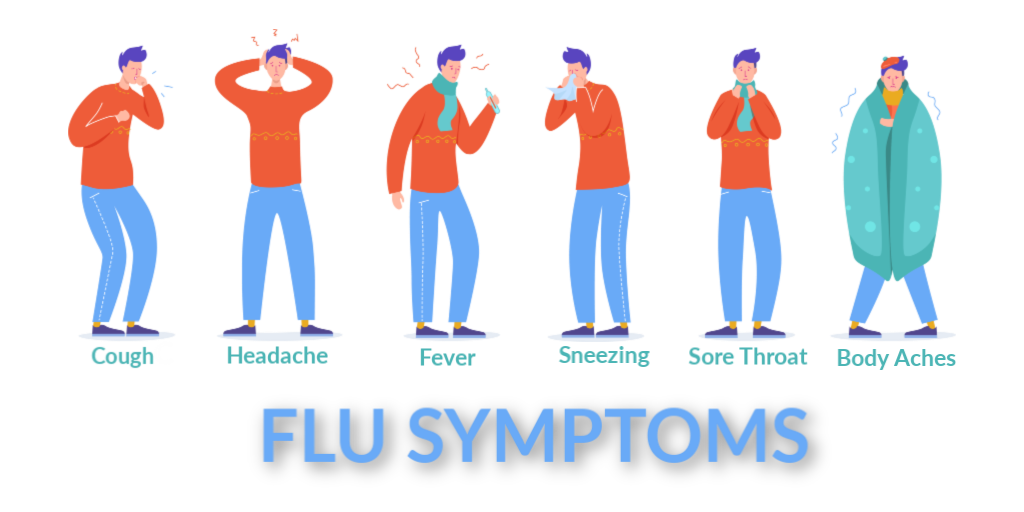
Flu symptoms are elusive. We hear symptoms of illness described as “flu-like”. What does that mean? How can you know if what you are feeling is a cold, or something more serious like the flu? If you’ve ever had the flu virus, you know. Fever, body aches, sneezing, cough, weakness, and sometimes even vomiting are part of what makes up the flu. That sounds pretty awful. Anyone surviving a bout of the flu feels like they should have gotten a t-shirt to commemorate their accomplishment. There are watercooler conversations at the office comparing notes about who’s symptoms were worse than others.
What’s really important are complications in young children or elderly family members. These populations are the most vulnerable and can result in deadly outcomes.
Deconstructing the Flu
There are three types of flu viruses: A, B, and C. Type A and B cause the annual Influenza epidemics that have up to 20% of the population sniffling, aching, coughing, and running high fevers. Type C also causes flu; however, type C flu symptoms are much less severe. The flu is linked to between 3,000 and 49,000 deaths and 200,000 hospitalizations each year in the United States. The seasonal flu vaccine was created to try to avert these epidemics (DerSarkissian 2019).
Type A Flu:
Can infect animals. Wild birds can be carriers. This strain changes genetically and can cause large epidemics.
Type B Flu:
This strain is only found in humans and has not been found to cause pandemics. Pandemics are a worldwide spread of a new disease. An Influenza pandemic occurs when a new Influenza virus emerges and spreads around the world, and most people do not have immunity (WHO 2015).
Type C Flu:
Found in people, mild and normally don’t create an epidemic.
The “Bird Flu”:
The Bird Flu is a type A virus. There are three main subtypes of avian flu, including H5, H7, and H9. The subtypes H5 and H7 are the most deadly, while the H9 subtype is less dangerous (DerSarkissian 2019). The bird virus we may have seen in the news was found in Asian countries. There is no vaccine for avian flus and even though the risk to US citizens is rare, we still need to be vigilant as we are a global community and may travel to Asia for business or recreation.
Individual Flu Symptoms

| Cough | A cough is the main reason people see a doctor every year. Some coughs can last weeks or months. (Ambardekar 2017) |
| Headache | Headache is pain in any region of the head. Headaches may occur on one or both sides of the head, be isolated to a certain location, radiate across the head from one point, or have a viselike quality. (Mayo Clinic 2018) |
| Fever | Fever is when a human’s body temperature goes above the normal range of 36–37° Centigrade (98–100° Fahrenheit). It is a common medical sign. (Brazier 2017) |
| Sneezing | Sneezing (sternutation) is the act of expelling a sudden and uncontrollable burst of air through the nose and mouth. Sneezing can occur for a variety of reasons that have in common an irritation of the lining (mucous membranes) of the nose or throat. (Stöppler 2019) |
| Sore Throat | A sore throat is pain, scratchiness or irritation of the throat that often worsens when you swallow. The most common cause of a sore throat (pharyngitis) is a viral infection, such as a cold or the flu. A sore throat caused by a virus resolves on its own. (Mayo Clinic 2019) |
| Body Aches | While body aches are usually harmless, it is helpful to understand what causes them and when to seek medical attention. Body aches can vary in intensity and frequency. A person may describe them as sharp, intermittent pains or a dull but persistent ache. People can often identify and treat body aches without seeing a doctor. Sometimes, however, they may need medical help. (Cadman 2019) |
Why Flu Vaccines Fail
The very first line defense to protect you and your family from the flu is the flu vaccine. Unfortunately, there is no absolute cure for Influenza. Vaccines are 40-60% effective. That means we benefit from having a flu vaccine, but it’s not 100% effective. Our recent article on “Why Flu Vaccines Fail” gives more information on flu vaccine effectiveness.
We are our own healthcare advocates. If you or a loved one has had a flu vaccine and is experiencing symptoms of the flu, time is of the essence. we can test for flu and resolve symptoms quickly with intervention. When flu vaccines fail, Elite Hospital Kingwood doesn’t.
Works Cited
DerSarkissian, Carol. “Different Types of Flu: Influenza A, B, C and More.” WebMD, WebMD, 7 Aug. 2019, https://www.webmd.com/cold-and-flu/advanced-reading-types-of-flu-viruses.
“What Is a Pandemic?” World Health Organization, World Health Organization, 21 June 2015, https://www.who.int/csr/disease/swineflu/frequently_asked_questions/pandemic/en/.
Ambardekar, Nayana. “Coughing Causes: Why You Cough & How To Prevent Coughing.” WebMD, WebMD, 25 Oct. 2017, https://www.webmd.com/cold-and-flu/overview#1.
“Headache.” Mayo Clinic, Mayo Foundation for Medical Education and Research, 11 Jan. 2018, https://www.mayoclinic.org/symptoms/headache/basics/definition/sym-20050800.
Brazier, Yvette. “Fever: Symptoms, Treatments, Types, and Causes.” Medical News Today, MediLexicon International, 7 Dec. 2017, https://www.medicalnewstoday.com/articles/168266.php.
Stöppler, Melissa Conrad. “Sneezing: Symptoms, Signs, Causes & Treatment.” MedicineNet, MedicineNet, 10 Sept. 2019, https://www.medicinenet.com/sneezing/symptoms.htm.
“Sore Throat.” Mayo Clinic, Mayo Foundation for Medical Education and Research, 7 May 2019, https://www.mayoclinic.org/diseases-conditions/sore-throat/symptoms-causes/syc-20351635.
Cadman, Bethany. “Body Aches: Causes and Treatments.” Medical News Today, MediLexicon International, 11 June 2019, https://www.medicalnewstoday.com/articles/319985.php#signs-and-symptoms-of-body-aches.
